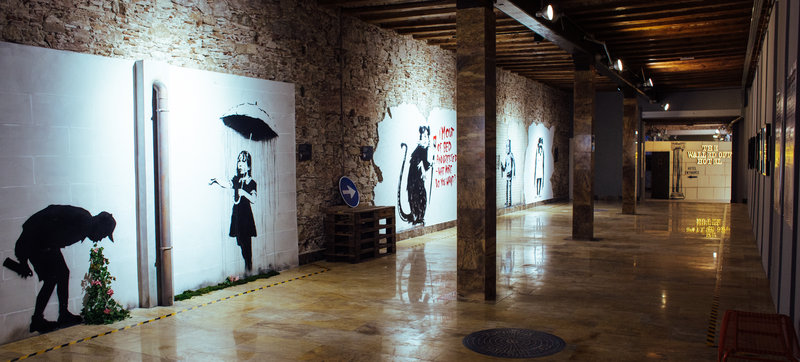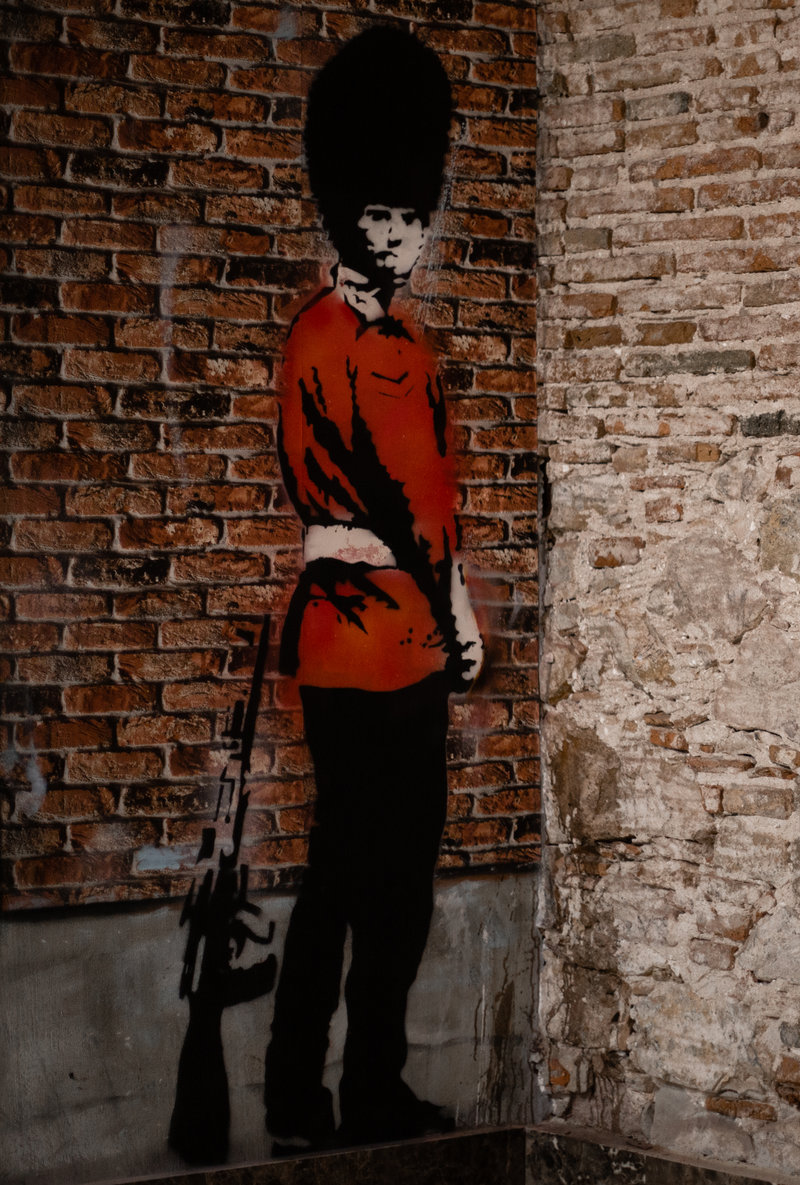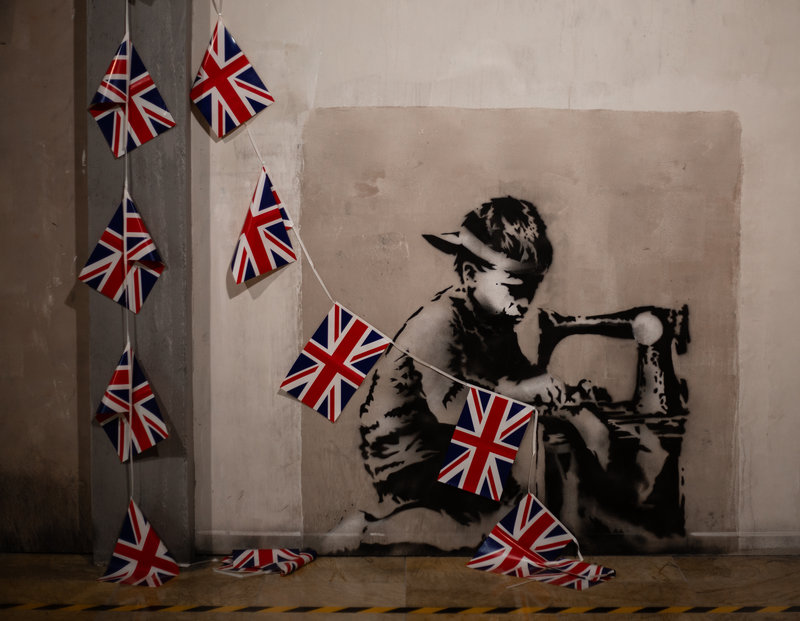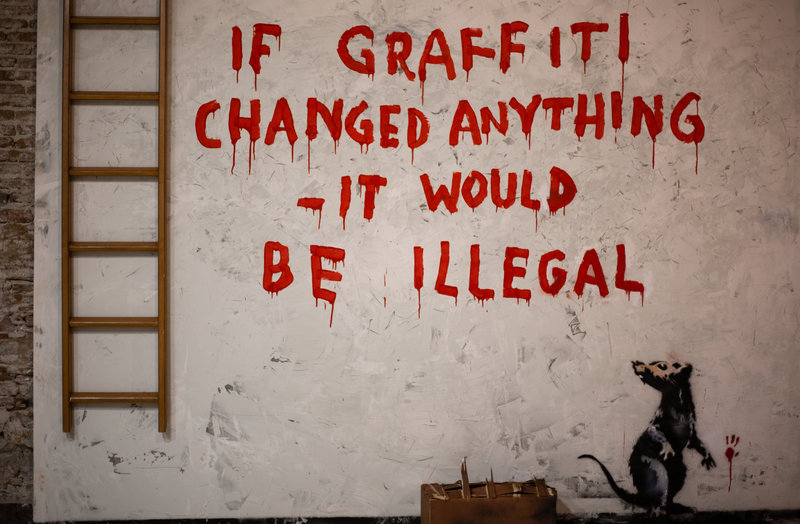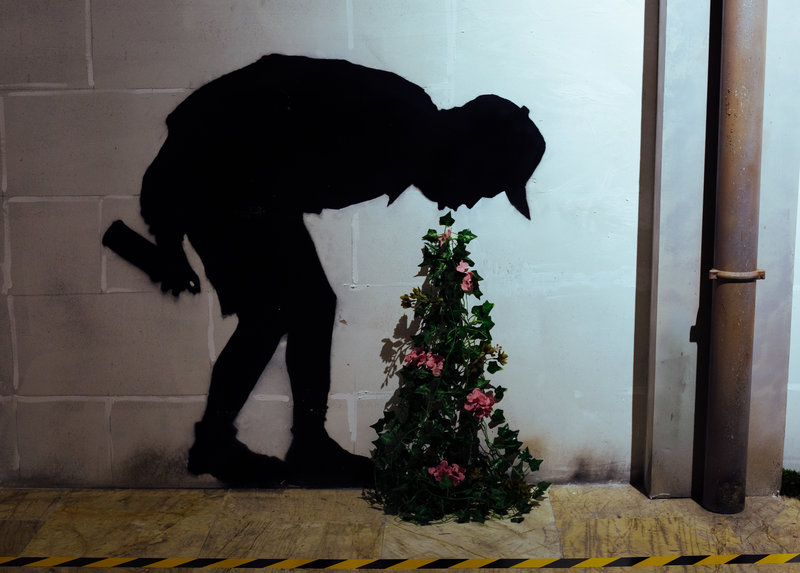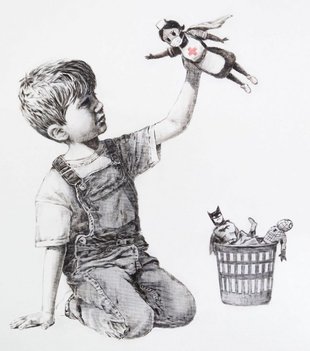Banksy: here to stay
The exhibition on the most well-known and global of urban street artists at the Espai Trafalgar gallery in the centre of Barcelona is hoping to become a permanent museum, and will get 17 new additions from November
Ironic, irreverent, activist, pacifist… The most famous and anonymous urban artist in the world is hard to define. Banksy is many things to many people, but he rarely leaves anyone indifferent. The Espai Trafalgar gallery in Barcelona, which is located on the street of the same name in the city centre, has been running the exhibition The World of Banksy dedicated to the artist since February last year. Despite being for closed three months due to health restrictions surrounding the pandemic, the exhibition was due to come to an end on December 31. However, the gallery now wants to make the exhibition permanent and call it the Banksy Museum. “The idea of the exhibition was to bring Banksy’s values closer. Unfortunately, Covid arrived and so given the situation at the moment it seems to me that the best way to ensure that the exhibition remains accessible to everyone is to make it permanent,” says Hazis Vardar, the Belgian curator of the exhibition.
What’s more, the Espai Trafalgar gallery will soon unveil a number of new arrivals to the exhibition. During November, some 17 new reproductions (11 murals and 6 paintings) will be added to the hundred or so that are already on display, which the artist painted between 2000 and 2018 in Palestine, New York, Bristol, Paris, London and Los Angeles. The new collection will feature, for example, the reproduction of Venice in Oil, a montage made in the Italian city in 2015 to condemn mass tourism. Also included will be Children on the Beach, made in 2005 in Bethlehem and criticising the wall separating Israel and Palestine, Keep your coins, I want change, painted in Melbourne in 2004, Rat with 3D Glasses, which appeared in Park City, Utah, in 2010, ’Aachoo!’ (sneezing old woman), made in Bristol in 2020, Basquiat, at the Walled Off Hotel in Palestine, and The Game Changer (not all superheroes wear capes), made in Southampton in 2020.
Luckily for those fans of Banksy who may have seen other exhibitions featuring the work of the master of urban art, the display at the Espai Trafalgar gallery has something extra to offer. “There have been other exhibitions displaying paintings of his work, but here I think that seeing his work in real size makes the experience better. In addition, most of them are works that no longer exist,” says Eliya Akbas, the gallery’s head.
Several anonymous French and Belgian artists have reproduced the more than a hundred works by the still unknown Banksy, who did not authorise the exhibition that also had a replica in Paris, in the Lafayette-Drouot gallery. “We hope that the Covid situation will soon be under control and that more and more people can come to visit this exhibition,” says Akbas, who also wants to make the Espai Trafalgar into a more social venue, with various events and music. “We have a room under construction where we want to put on exhibitions by different artists every two or three months. If they are street artists, all the better, but we’re also open to other options. We want to use the Banksy name to help these young artists,” Akbas adds.
The Palestine conflict
The Espai Trafalgar gallery also hosts workshops aimed at young graffiti artists, who are encouraged to create and develop their imagination on the gallery’s walls on the ground floor or in the basement. This is where the final part of the Banksy exhibition is located and is arguably the area that contains the most striking works, such as the collection of the artist’s creations in the United States and, especially, in Bethlehem. It was there that he left a huge painting, on the wall separating Israel and the occupied territories of Gaza and the West Bank. The nine-metre concrete wall undoubtedly inspired Banksy’s enormous capacity for condemnation and protest. In 2005 alone he made nine murals, including some of his most famous, such as the one of a protester throwing a bouquet of flowers instead of a Molotov cocktail, or the one of a small girl patting down a soldier.
One of the most interesting reproductions in the gallery, and one of the most celebrated artistic commentaries on human conflict of recent times, is the Israeli-Palestinian Pillow Fight, originally painted on a wall of one of the rooms of the Walled Off Hotel, which shows an Isreali soldier and a Palestinian protester fighting with pillows amid a rain of feathers. It’s an ironic and absurdist satirical statement that sums up the essence of Banksy’s work. More work from Los Angeles (2002), New Orleans (2008), San Francisco (2010) and New York (2013) are also displayed on the same floor of the Barcelona gallery.
The visit, however, starts on the ground floor of the Espai Trafalgar, where the visitor is introduced to Banksy’s beginnings in his native Britain. Some 80% of his earlier work was done between the cities of London and Bristol. An example is the Mild Mild West, which was his first mural in 1997, in what is believed to be his native Bristol. His debut mural depicted a teddy bear throwing a Molotov cocktail at three riot police. The anti-system and anti-capitalist spirit was very much present in Banksy’s early work, which established the use of mockery, irony and satire as the main tools for his public condemnations. Yet they are also masterful and innovative depictions that established Banksy’s very particular style. Only he, for example, could have come up with the painting of the two police officers kissing or the well-known No Ball Games mural showing two children playing with a sign prohibiting ball games.
Route around Paris
On the first floor of the gallery, the exhibition focuses on Banksy’s time in Paris, and includes several videos, such as one showing the sale of his works for 60 dollars in New York’s Central Park. In another video, the geography of the French capital provides context for the work he carried out there in 2018. The Pompidou Centre, the Porte de la Chapelle, Montmartre, Rue Victor Cousin, the Seine or the Avenue de Flandre were all landmark places chosen by Banksy to host nine of his artworks. He also paid tribute to the victims of the 2015 terrorist attack by painting a work called The Sad Girl on the emergency door of the Bataclan theatre; the work was later stolen. Another key artwork in Paris that no longer exists is the famous image of the girl painting over a swastika, which became the victim of vandalism.
It is hard to dispute the argument that the key to Banksy’s work is its capacity to cross borders in order to strike at the heart of universal issues such as love, war, consumption, or oppression. “I think he’s an artist who thinks the content of the message is more important than who is writing it. It’s a very humble and selfless approach, very strange in our time when everyone wants to be famous in just a few clicks,” says Hazis Vardar. “He acts at night, quickly and anonymously, and the only trace he leaves is his work and his message. These artworks are very contemporary and relevant. In Israel, for example, he denounces the wall, in France he condemns the left wing and the terror attacks, in the United States his target is capitalism. He is always connecting with the place and the moment,” he adds.
Hidden and at night
Banksy is a global street artist with a plan, as well as a team to help him to avoid the authorities. “In the end, the technique is not the thing that is so difficult, because Banksy uses sprays and stencils. What’s difficult is the idea, creating the message. That’s the most important thing. Organising it is also very difficult. There is a large team around Banksy that helps him do the work at night. Street art is illegal, after all,” points out Akbas, who compares Banksy to one of the first graffiti artists, the Frenchman, Blek le Rat. “Their work is very accessible. They are universal. And that is very difficult for any artist to achieve. At the same time they are very simple, and attaining simplicity is the hardest part. Banksy’s artworks have a story behind them, which provides him with a vision that he knows how to describe with a single image. For example, in the wake of the Covid pandemic, the image he came up with was of a child playing with a toy nurse,” says Akbas. Slave Labour and Pissing Soldier, both made in London in 2012, also show Banksy’s use of simplicity to tackle complex concepts.
Contradictory?
“There’s nothing more dangerous than someone who wants to make the world a better place.” This phrase from Banksy himself could seem to be a contradiction from someone who uses street art to expose and condemn many of the injustices and imbalances that plague the planet. “There’s nothing worse than people promising a better world, in which they would be the new kings. Overall, that world would be better just for them. Banksy denounces what is wrong. He’s not running in the elections,” says the curator of the exhibition.
Banksy is also a declared enemy of copyright. And he isn’t shy when it comes to criticising exhibitions of his work that he doesn’t like. “Banksy’s position on this issue is very clear. He is against copyright, condemning people who are rich and who get richer speculating on artworks, including their own. For this exhibition, the work has been done by street artists and cannot be sold. But we also have to pay the rent and salaries. Banksy has a list in which he cites the exhibitions he doesn’t like, and this one in Barcelona is not on his list,” Hazis Vardar explains.
Wherever it might appear, Banksy’s work is instantly recognisable. “Arguably one of his most famous artworks is the mural of the little girl holding a heart-shaped balloon (There is always hope). As soon as you see it you know it’s by Banksy. But if you ask me, the most important work is what he did on the wall in Bethlehem, where he tackles a conflict that has lasted for too many decades,” says Akbas.
Banksy’s anti-war stance comes across loud and clear in the Barcelona exhibition, and the street artist does not pull his punches when it comes to predicting the potential outcome should we fail to learn and change our ways. “Laugh now, but one day we’ll be in charge,” is the message witten on a sandwich board worn by a monkey in one of his murals, in a nod to the film The Planet of the Apes. Both the work and the message are very Banksy indeed.
feature art
feature art
Banksy’s anonymity Criticism of tourism
Who is Banksy? The identity of the world’s most celebrated street artist still remains unknown except to a very few who guard the secret. What we think we know about the artist is that he is British-born, in the city of Bristol, between 1973 and 1974. Yet the enigma surrounding the artist whose artworks can go for millions of euros at auction remains. Banksy’s anonymity has inevitably helped to magnify the legend, because “we all want to know who Banksy is,” as gallery head Eliya Akbas puts it. “There is even a theory that he’s the lead singer of the music group Massive Attack,” he adds. Despite his fame over so many years, Banksy has managed to keep his real identity hidden from the press, the authorities and even his followers. In 2010, Banksy released his first film as a filmmaker, the documentary Exit Through the Gift Shop, although it gave no clue to who he really is.
Among the 17 new additions to the exhibition that are due during November is the artwork Banksy did in Venice in 2015, called Venice in Oil, which condemned cruise tourism to the Italian city. The artist made a montage on the street with several paintings that together formed the image of a huge cruise ship arriving in the city of canals. Venice was the ideal setting for another of Banksy’s criticisms of uncontrolled global consumerism. Among the other additions due at the new Banksy Museum this month are reproductions of artworks the urban artist did in Israel, Australia, Utah, Bristol and Southampton.

